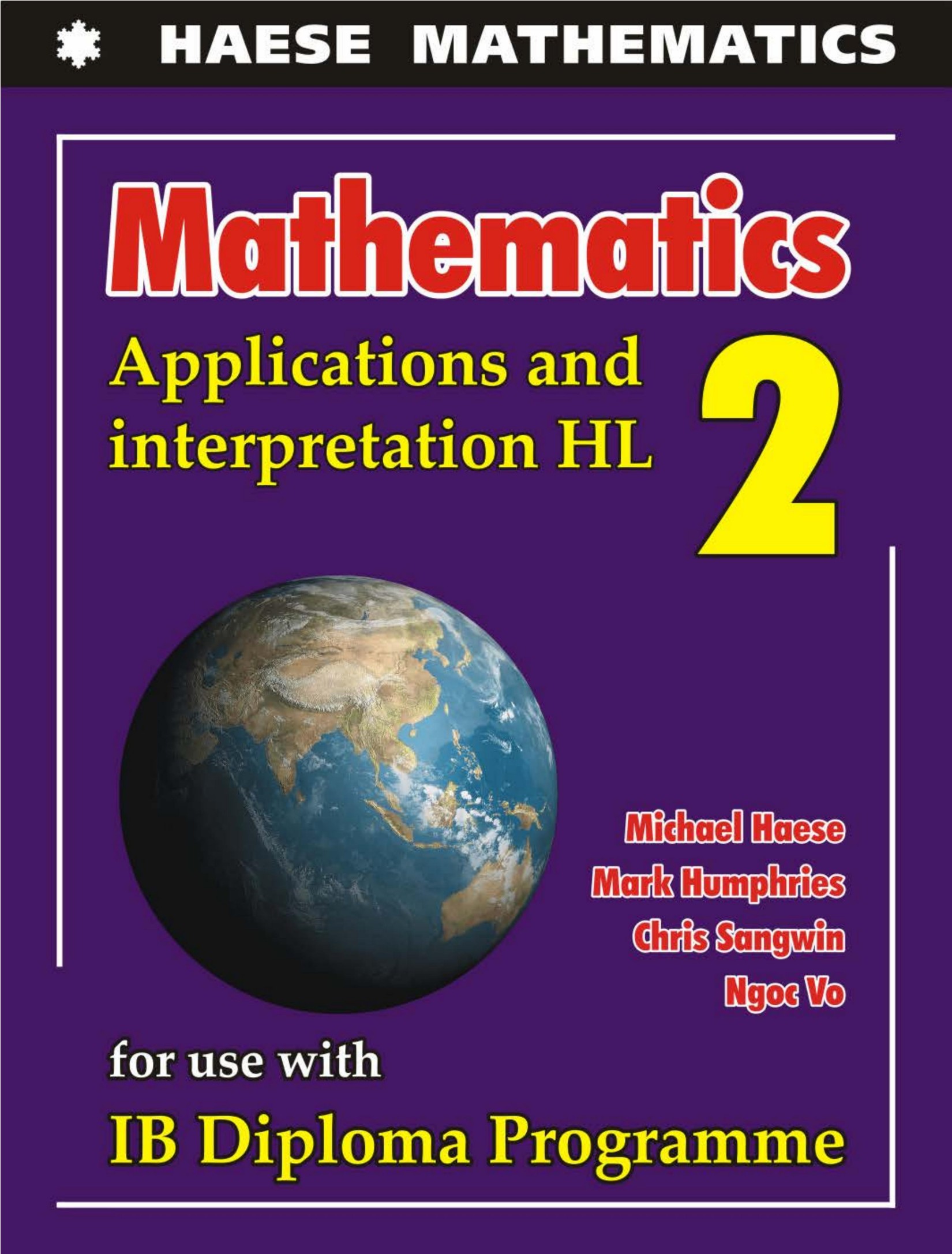Mathematics Applications and Interpretation HL 2 1st edition by Michael Haese,Mark Humphries,hris Sangwin,Ngoc Vo 9781925489606 1925489604
$70.00 Original price was: $70.00.$35.00Current price is: $35.00.
Instant download Mathematics Applications and Interpretation HL 2 after payment
Mathematics Applications and Interpretation HL 2 1st edition by Michael Haese,Mark Humphries,hris Sangwin – Ebook PDF Instant Download/Delivery:9781925489606,1925489604
Full dowload Mathematics Applications and Interpretation HL 2 1st edition after payment
Product details:
ISBN 10:1925489604
ISBN 13:9781925489606
Author: Michael Haese,Mark Humphries,hris Sangwin,Ngoc Vo
This book is designed to complete the course in conjunction with the Mathematics: Core Topics HL textbook. It is expected that students will start using this book approximately 6-7 months into the two-year course, upon the completion of the Core Topics HL textbook.
This product has been developed independently from and is not endorsed by the International Baccalaureate Organization. International Baccalaureate, Baccalaureát International, Bachillerato Internacional and IB are registered trademarks owned by the International Baccalaureate Organization.
Mathematics Applications and Interpretation HL 2 1st Table of contents:
CHAPTER 1: EXPONENTIALS
A Rational exponents
B Algebraic expansion and factorisation
C Exponential functions
D Graphing exponential functions from a table of values
E Graphs of exponential functions
F Exponential equations
G Growth and decay
H The natural exponential
I The logistic model
CHAPTER 2: LOGARITHMS
A Logarithms in base 10
B Laws of logarithms
C Natural logarithms
D Logarithmic functions
E Logarithmic scales
CHAPTER 3: APPROXIMATIONS AND ERROR
A Errors in measurement
B Absolute and percentage error
CHAPTER 4: LOANS AND ANNUITIES
A Loans
B Annuities
CHAPTER 5: MODELLING
A The modelling cycle
B Linear models
C Piecewise models
D Systems of equations
CHAPTER 6: DIRECT AND INVERSE VARIATION
A Direct variation
B Powers in direct variation
C Inverse variation
D Powers in inverse variation
E Determining the variation model
F Using technology to find variation models
CHAPTER 7: BIVARIATE STATISTICS
A Association between numerical variables
B Pearson’s product-moment correlation coefficient
C The coefficient of determination
D Line of best fit by eye
E The least squares regression line
F Statistical reliability and validity
G Spearman’s rank correlation coefficient
CHAPTER 8: NON-LINEAR MODELLING
A Logarithmic models
B Exponential models
C Power models
D Problem solving
E Non-linear regression
CHAPTER 9: VECTORS
A Vectors and scalars
B Geometric operations with vectors
C Vectors in the plane
D The magnitude of a vector
E Operations with plane vectors
F Vectors in space
G Operations with vectors in space
H The vector between two points
I Parallelism
J The scalar product of two vectors
K The angle between two vectors
L The vector product of two vectors
M Vector components
CHAPTER 10: VECTOR APPLICATIONS
A Lines in 2 and 3 dimensions
B The angle between two lines
C Constant velocity problems
D The shortest distance from a point to a line
E The shortest distance between two objects
F Intersecting lines
CHAPTER 11: COMPLEX NUMBERS
A Real quadratics with ∆ < 0
B Complex numbers
C Operations with complex numbers
D Equality of complex numbers
E The complex plane
F Modulus and argument
G Geometry in the complex plane
H Polar form
I Exponential form
J Frequency and phase
CHAPTER 12: MATRICES
A Matrix structure
B Matrix equality
C Addition and subtraction
D Scalar multiplication
E Matrix algebra
F Matrix multiplication
G The inverse of a matrix
H Simultaneous linear equations
CHAPTER 13: EIGENVALUES AND EIGENVECTORS
A Eigenvalues and eigenvectors
B Matrix diagonalisation
C Matrix powers
D Markov chains
CHAPTER 14: AFFINE TRANSFORMATIONS
A Translations
B Rotations about the origin
C Reflections
D Stretches
E Enlargements
F Composite transformations
G Area
CHAPTER 15: GRAPH THEORY
A Graphs
B Properties of graphs
C Routes on graphs
D Adjacency matrices
E Transition matrices for graphs
F Trees
G Minimum spanning trees
H Eulerian graphs
I The Chinese Postman Problem
J Hamiltonian graphs
K The Travelling Salesman Problem
CHAPTER 16: VORONOI DIAGRAMS
A Voronoi diagrams
B Constructing Voronoi diagrams
C Adding a site to a Voronoi diagram
D Nearest neighbour interpolation
E The Largest Empty Circle problem
CHAPTER 17: INTRODUCTION TO DIFFERENTIAL CALCULUS
A Rates of change
B Instantaneous rates of change
C Limits
D The gradient of a tangent
E The derivative function
F Differentiation from first principles
CHAPTER 18: RULES OF DIFFERENTIATION
A Simple rules of differentiation
B The chain rule
C The product rule
D The quotient rule
E Derivatives of exponential functions
F Derivatives of logarithmic functions
G Derivatives of trigonometric functions
H Second derivatives
CHAPTER 19: PROPERTIES OF CURVES
A Tangents
B Normals
C Increasing and decreasing
D Stationary points
E Shape
F Inflection points
CHAPTER 20: APPLICATIONS OF DIFFERENTIATION
A Rates of change
B Optimisation
C Modelling with calculus
D Related rates
CHAPTER 21: INTRODUCTION TO INTEGRATION
A Approximating the area under a curve
B The Riemann integral
C Antidifferentiation
D The Fundamental Theorem of Calculus
CHAPTER 22: TECHNIQUES FOR INTEGRATION
A Discovering integrals
B Rules for integration
C Particular values
D Integrating f(ax + b)
E Integration by substitution
CHAPTER 23: DEFINITE INTEGRALS
A Definite integrals
B Definite integrals involving substitution
C The area under a curve
D The area above a curve
E The area between a curve and the y-axis
F Solids of revolution
G Problem solving by integration
CHAPTER 24: KINEMATICS
A Displacement
B Velocity
C Acceleration
D Speed
E Velocity and acceleration in terms of displacement
F Motion with variable velocity
G Projectile motion
CHAPTER 25: DIFFERENTIAL EQUATIONS
A Differential equations
B Solutions of differential equations
C Differential equations of the form dy
dx = f(x)
D Separable differential equations
E Slope fields
F Euler’s method for numerical integration
CHAPTER 26: COUPLED DIFFERENTIAL EQUATIONS
A Phase portraits
B Coupled linear differential equations
C Second order differential equations
D Euler’s method for coupled equations
CHAPTER 27: DISCRETE RANDOM VARIABLES
A Random variables
B Discrete probability distributions
C Expectation
D Variance and standard deviation
E Properties of aX + b
F The binomial distribution
G Using technology to find binomial probabilities
H The mean and standard deviation of a binomial distribution
I The Poisson distribution
CHAPTER 28: THE NORMAL DISTRIBUTION
A Introduction to the normal distribution
B Calculating probabilities
C The standard normal distribution
D Quantiles
CHAPTER 29: ESTIMATION AND CONFIDENCE INTERVALS
A Linear combinations of random variables
B The sum of two independent Poisson random variables
C Linear combinations of normal random variables
D The Central Limit Theorem
E Confidence intervals for a population mean with known variance
F Confidence intervals for a population mean with unknown variance
CHAPTER 30: HYPOTHESIS TESTING
A Statistical hypotheses
B The Z-test
C Critical values and critical regions
D Student’s t-test
E Paired t-tests
F The two-sample t-test for comparing population means
G Hypothesis tests for the mean of a Poisson population
H Hypothesis tests for a population proportion
I Hypothesis tests for a population correlation coefficient
J Error probabilities and statistical power
CHAPTER 31: χ
2 HYPOTHESIS TESTS
A The χ
2 goodness of fit test
B Estimating distribution parameters in a goodness of fit test
C Critical regions and critical valu
People also search for Mathematics Applications and Interpretation HL 2 1st :
mathematics applications and interpretation hl
ib mathematics applications and interpretation hl answer key
applications and interpretations hl
ib mathematics applications and interpretation hl
mathematics applications and interpretation hl 2 pdf



